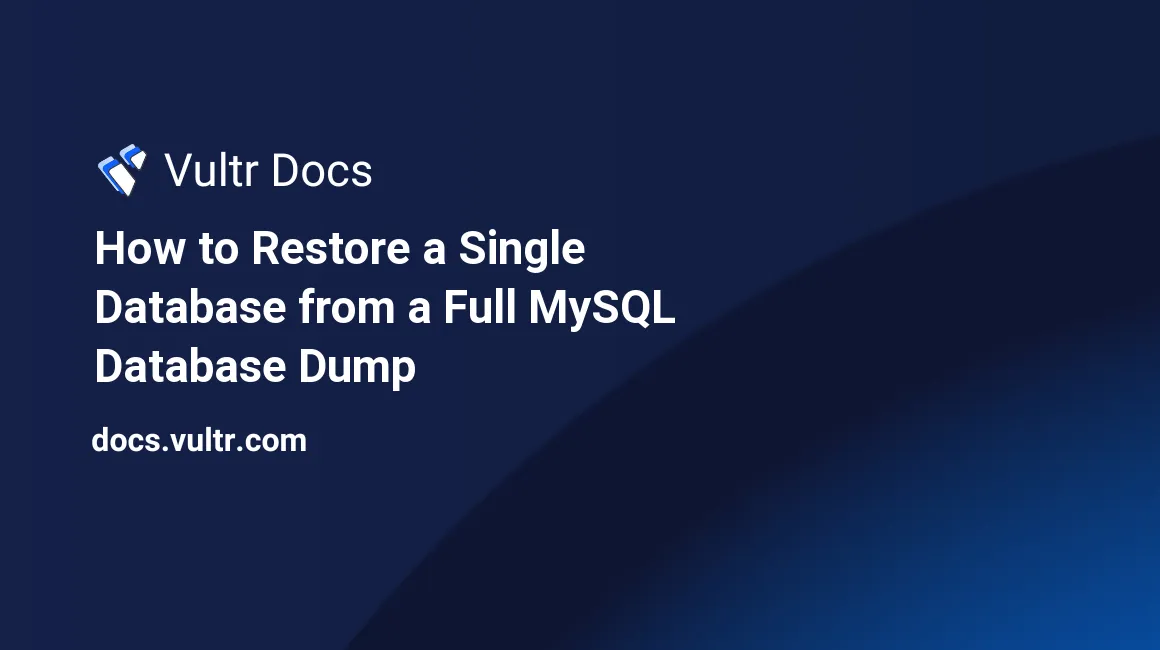How to Restore a Single Database from a Full MySQL Database Dump

Introduction
Restoring a single database from a full MySQL database dump can save time and resources when you only need specific data. Whether you're recovering a WordPress site or managing multiple databases, this process ensures you extract and restore only the required database without affecting the rest of the dump.
MySQL Dump is a backup utility used to recover your databases and tables in case your database server crashes. A single MySQL Database Dump is a logical backup in a flat file with Standard Query Language (SQL) statements that restore a database to its original state before backup.
MySQL dump files are important when transferring databases from one server to another or when recovering the database server from a crash. This guide illustrates how you can restore a single database from a full MySQL database dump consisting of two or more databases.
Prerequisites
Before you start, make sure you:
- Have a running MySQL database server.
- SSH and Login to the MySQL database server.
Create a Full MySQL Dump
To create a Full MySQL database dump, make sure you have two or more databases available on your database server. For purposes of this guide, create three new databases on your server as below.
Log in to the MySQL console.
$ mysqlCreate the databases.
mysql> CREATE DATABASE db1; CREATE DATABASE db2; CREATE DATABASE exampledb3;Switch to the
db1database.mysql> use db1;Add a new table to the database.
mysql> CREATE TABLE Example ( ID int, FirstName varchar(255), LastName varchar(255), Country varchar(255), City varchar(255) );Create a new privileged user.
mysql> CREATE USER 'myuser'@'localhost' IDENTIFIED BY 'strong-password';Grant the user full privileges to all databases.
mysql> GRANT ALL PRIVILEGES ON *.* TO 'myuser'@'localhost';Reload MySQL privileges.
mysql> FLUSH PRIVILEGES;Exit the console.
mysql> EXITCreate a full MySQL dump of all databases.
$ mysqldump -u myuser -p --all-databases > backup.dumpA new
backup.dumpfile is added to your working directory.For restoration purposes, re-login to the MySQL console.
$ mysql -u myuser -pDelete the databases you created earlier.
mysql> DROP DATABASE db1; mysql> DROP DATABASE db2; mysql> DROP DATABASE exampledb3;Exit the MySQL console.
mysql> EXIT
Restore a Single Database from a Full MySQL Database Dump
To restore a single database from a full MySQL dump, you should create an empty database with the same name, then restore the single database to recover all its tables and table data. For this guide, restore the db1 database as below.
Verify that the full MySQL dump file exists in your working directory.
$ ls -lOutput:
-rw-r--r-- 1 example example 264261856 Sep 21 14:06 backup.dumpRestore the
db1database from the full MySQL dump to a new file without importing it to the database server.$ sed -n '/^-- Current Database: `db1`/,/^-- Current Database: `/p' backup.dump > db1.sqlImport the single database file to the database server.
$ mysql -u myuser -p < db1.sqlWhen the command completes, re-login to the MySQL console to verify changes.
$ mysql -u myuser -pSwitch to the
db1database.mysql> use db1;Show all tables to verify that your data is available.
mysql> show tables;Output:
+---------------+ | Tables_in_db1 | +---------------+ | Example | +---------------+ 1 row in set (0.00 sec)Exit the MySQL console, and restore any other databases.
mysql> EXIT
Restore a single Table from a MySQL Database Dump
Back up the
exampletable from thedb1database using the following command.$ mysqldump -u myuser -p db1 example > example-tbl.sqlAssuming you want to restore the
example-tbl.sqlfile to a new database such asdb2, run the following command.$ mysql -u myuser -p db2 < example-tbl.sqlLogin to the MySQL console.
$ mysql -u myuser -pSwitch to the
db2database.mysql> use db2;Verify that the
exampletable is available.mysql> show tables;Exit the console.
mysql> EXIT
You can back up database tables and restore them to any other databases without any restriction on the source database name.
Conclusion
You have restored a single database from a full MySQL Database dump on your database server. You can automate periodic MySQL backups and restore them to a new server or in case the database server crashes. For more information, please visit the following resources.